編輯:關於android開發
一般手機都是需要上網的,一般我們的浏覽器就是個webview。這裡簡單實現下下功能,先編寫Android的layout布局:
<!--{cke_protected}{C}%3C!%2D%2D%3Fxml%20version%3D%221.0%22%20encoding%3D%22utf-8%22%3F%2D%2D%3E-->
<linearlayout xmlns:android="http://schemas.android.com/apk/res/android" xmlns:tools="http://schemas.android.com/tools" android:layout_width="match_parent" android:layout_height="match_parent" android:orientation="vertical" android:layout_margin="10dp" android:padding="10dp" tools:context="com.example.jared.webviewstudy.MainActivity">
<linearlayout android:layout_width="match_parent" android:layout_height="wrap_content">
<edittext android:id="@+id/netAddress" android:layout_weight="1" android:layout_width="wrap_content" android:layout_height="wrap_content"><button android:id="@+id/openNetAddress" android:layout_height="wrap_content" android:layout_width="wrap_content" android:layout_weight="0" android:text="Open" android:textallcaps="false">
<webview android:id="@+id/webView" android:layout_width="match_parent" android:layout_height="match_parent">
</webview></button></edittext></linearlayout></linearlayout>
package com.example.jared.webviewstudy;
import android.os.Bundle;
import android.support.v7.app.AppCompatActivity;
import android.view.View;
import android.webkit.WebView;
import android.webkit.WebViewClient;
import android.widget.Button;
import android.widget.EditText;
public class MainActivity extends AppCompatActivity {
private WebView myWebView;
private EditText networkAddr;
private Button openNetwork;
@Override
protected void onCreate(Bundle savedInstanceState) {
super.onCreate(savedInstanceState);
setContentView(R.layout.activity_main);
networkAddr = (EditText)findViewById(R.id.netAddress);
myWebView = (WebView)findViewById(R.id.webView);
openNetwork = (Button)findViewById(R.id.openNetAddress);
openNetwork.setOnClickListener(new myOnClickListener());
}
class myOnClickListener implements View.OnClickListener {
@Override
public void onClick(View view) {
myWebView.getSettings().setJavaScriptEnabled(true);
myWebView.setWebViewClient(new WebViewClient() {
@Override
public boolean shouldOverrideUrlLoading(WebView view, String url) {
view.loadUrl(url);
return true;
}
});
String networkAddress = networkAddr.getText().toString();
myWebView.loadUrl("http://"+networkAddress);
}
}
}
還有就是權限問題了:
<uses-permission android:name="android.permission.INTERNET">
</uses-permission>
這裡通過setWebViewClient方法,實例化一個WebViewClient,loadurl實現網頁的加載。運行看下效果:
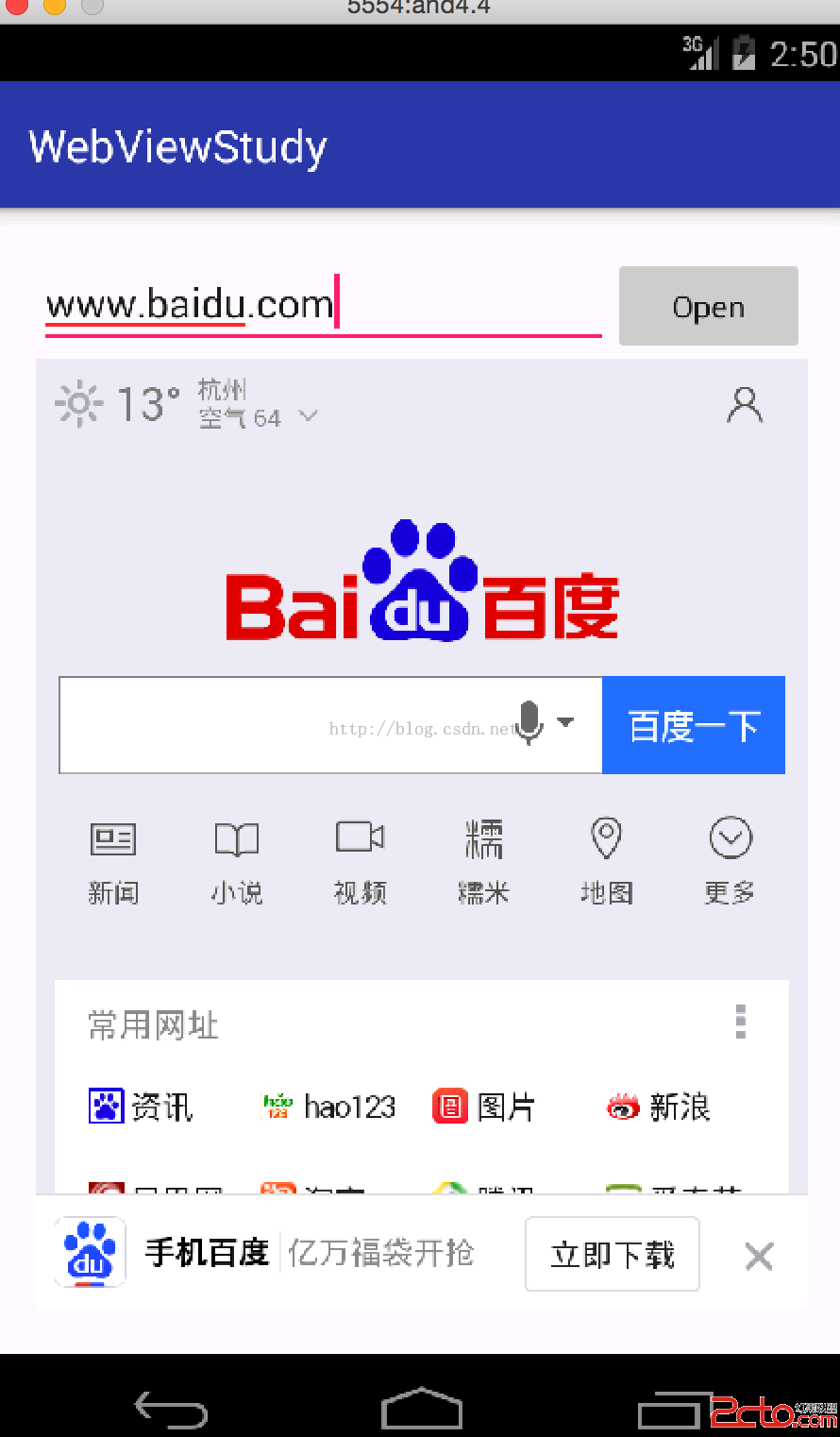
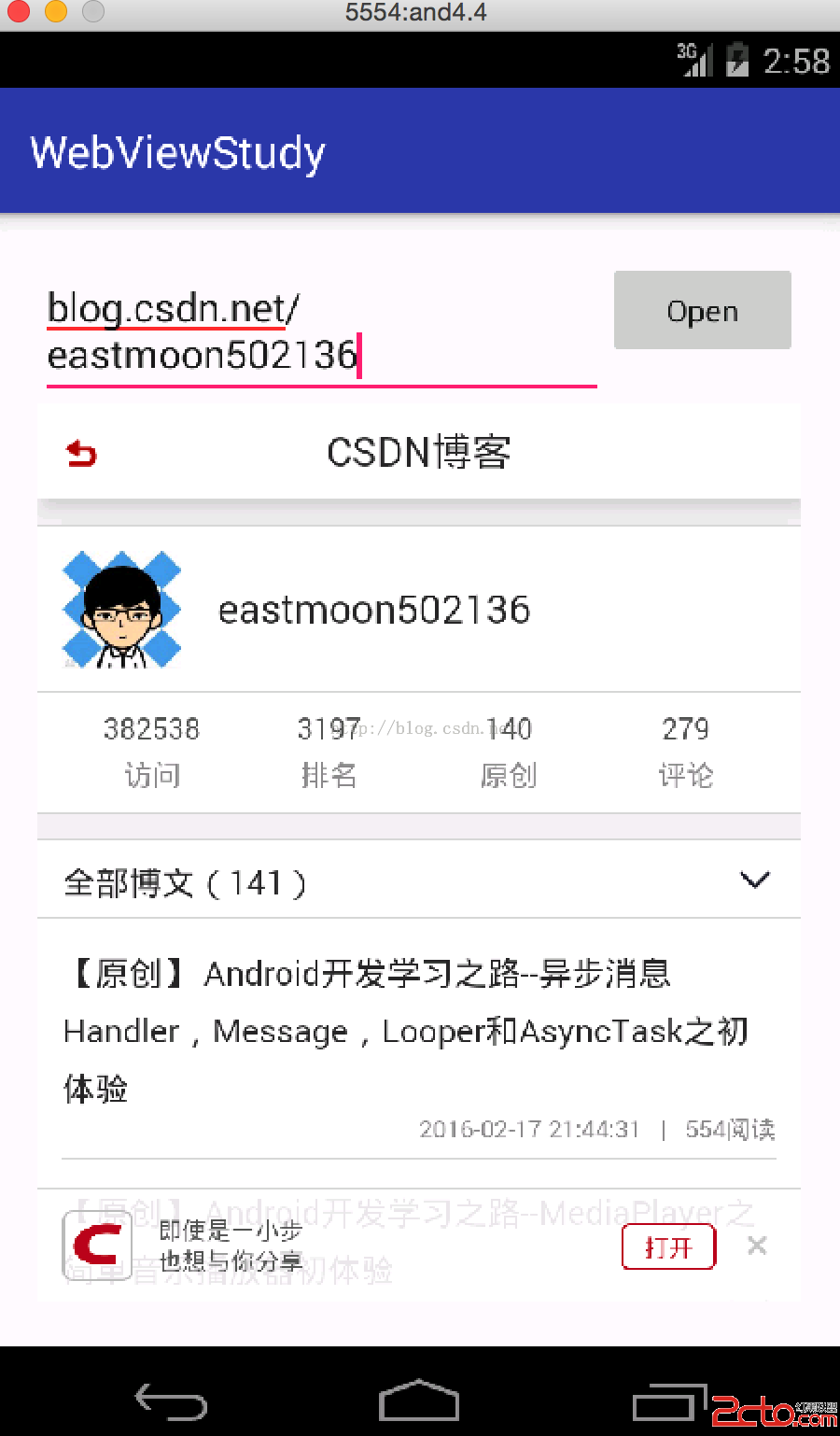
這裡打開了百度和我的博客的地址,界面略難看,勉強看看了。
一般網絡編程都是通過http的,下面就來實現下,首先是HttpURLConnection,這個一般是google官方提供的,還有一個HttpClient,本來有的,現在api23也沒有了,需要自己加載進來。
先使用HttpURLConnection和HttpClient吧,新建工程,編寫layout代碼如下:
<!--{cke_protected}{C}%3C!%2D%2D%3Fxml%20version%3D%221.0%22%20encoding%3D%22utf-8%22%3F%2D%2D%3E-->
<linearlayout xmlns:android="http://schemas.android.com/apk/res/android" xmlns:tools="http://schemas.android.com/tools" android:layout_width="match_parent" android:layout_height="match_parent" android:orientation="vertical" android:layout_margin="10dp" tools:context="com.example.jared.httpurlconnectionstudy.MainActivity"><button android:id="@+id/sendRequest" android:text="發送請求" android:layout_width="match_parent" android:layout_height="wrap_content">
<scrollview android:layout_width="match_parent" android:layout_height="match_parent">
<textview android:id="@+id/response" android:layout_width="match_parent" android:layout_height="wrap_content">
</textview></scrollview></button></linearlayout>
編寫MainActivity,裡面有實現了HttpURLConnection和HttpClient:
package com.example.jared.httpurlconnectionstudy;
import android.os.Bundle;
import android.os.Handler;
import android.os.Message;
import android.support.v7.app.ActionBar;
import android.support.v7.app.AppCompatActivity;
import android.view.View;
import android.widget.Button;
import android.widget.TextView;
import org.apache.http.HttpEntity;
import org.apache.http.HttpResponse;
import org.apache.http.client.HttpClient;
import org.apache.http.client.methods.HttpGet;
import org.apache.http.impl.client.DefaultHttpClient;
import org.apache.http.util.EntityUtils;
import java.io.BufferedReader;
import java.io.InputStream;
import java.io.InputStreamReader;
import java.net.HttpURLConnection;
import java.net.URL;
public class MainActivity extends AppCompatActivity {
private static final int SHOW_RESPONSE = 1;
private Button sendRequestBtn;
private TextView responseView;
private Handler mHandler = new Handler(){
@Override
public void handleMessage(Message msg) {
switch (msg.what) {
case SHOW_RESPONSE:
String responseContent = (String)msg.obj;
responseView.setText(responseContent);
break;
}
}
};
@Override
protected void onCreate(Bundle savedInstanceState) {
super.onCreate(savedInstanceState);
ActionBar actionBar = getSupportActionBar();
actionBar.hide();
setContentView(R.layout.activity_main);
responseView = (TextView)findViewById(R.id.response);
sendRequestBtn = (Button)findViewById(R.id.sendRequest);
sendRequestBtn.setOnClickListener(new myOnClickListener());
}
private class myOnClickListener implements View.OnClickListener {
@Override
public void onClick(View view) {
switch (view.getId()) {
case R.id.sendRequest:
String url = "http://www.baidu.com";
//sendRequestWithHttpURLConnection(url);
sendRequestWithHttpClient(url);
break;
default:
break;
}
}
}
private void sendRequestWithHttpClient(final String url) {
new Thread(new Runnable() {
@Override
public void run() {
try {
HttpClient httpClient = new DefaultHttpClient();
HttpGet httpGet = new HttpGet(url);
HttpResponse httpResponse = httpClient.execute(httpGet);
if(httpResponse.getStatusLine().getStatusCode() == 200) {
HttpEntity entity = httpResponse.getEntity();
String response = EntityUtils.toString(entity, "utf-8");
Message message = new Message();
message.what = SHOW_RESPONSE;
message.obj = response.toString();
mHandler.sendMessage(message);
}
} catch (Exception e) {
e.printStackTrace();
}
}
}).start();
}
private void sendRequestWithHttpURLConnection(final String url) {
new Thread(new Runnable() {
@Override
public void run() {
HttpURLConnection connection = null;
try {
URL mUrl = new URL(url);
connection = (HttpURLConnection)mUrl.openConnection();
connection.setRequestMethod("GET");
connection.setConnectTimeout(8000);
connection.setReadTimeout(8000);
InputStream in = connection.getInputStream();
BufferedReader reader = new BufferedReader(new InputStreamReader(in));
StringBuilder response = new StringBuilder();
String line;
while((line = reader.readLine()) != null) {
response.append(line);
}
Message message = new Message();
message.what = SHOW_RESPONSE;
message.obj = response.toString();
mHandler.sendMessage(message);
} catch (Exception e) {
e.printStackTrace();
} finally {
if (connection != null) {
connection.disconnect();
}
}
}
}).start();
}
}
在build.gradle下面添加
// Apache Http
android {
useLibrary 'org.apache.http.legacy'
}
// Header
dependencies {
compile "org.apache.httpcomponents:httpcore:4.3.2"
}
這樣HttpClient就可以使用了,關於加載別的庫,也基本上類似了。
運行效果如下:
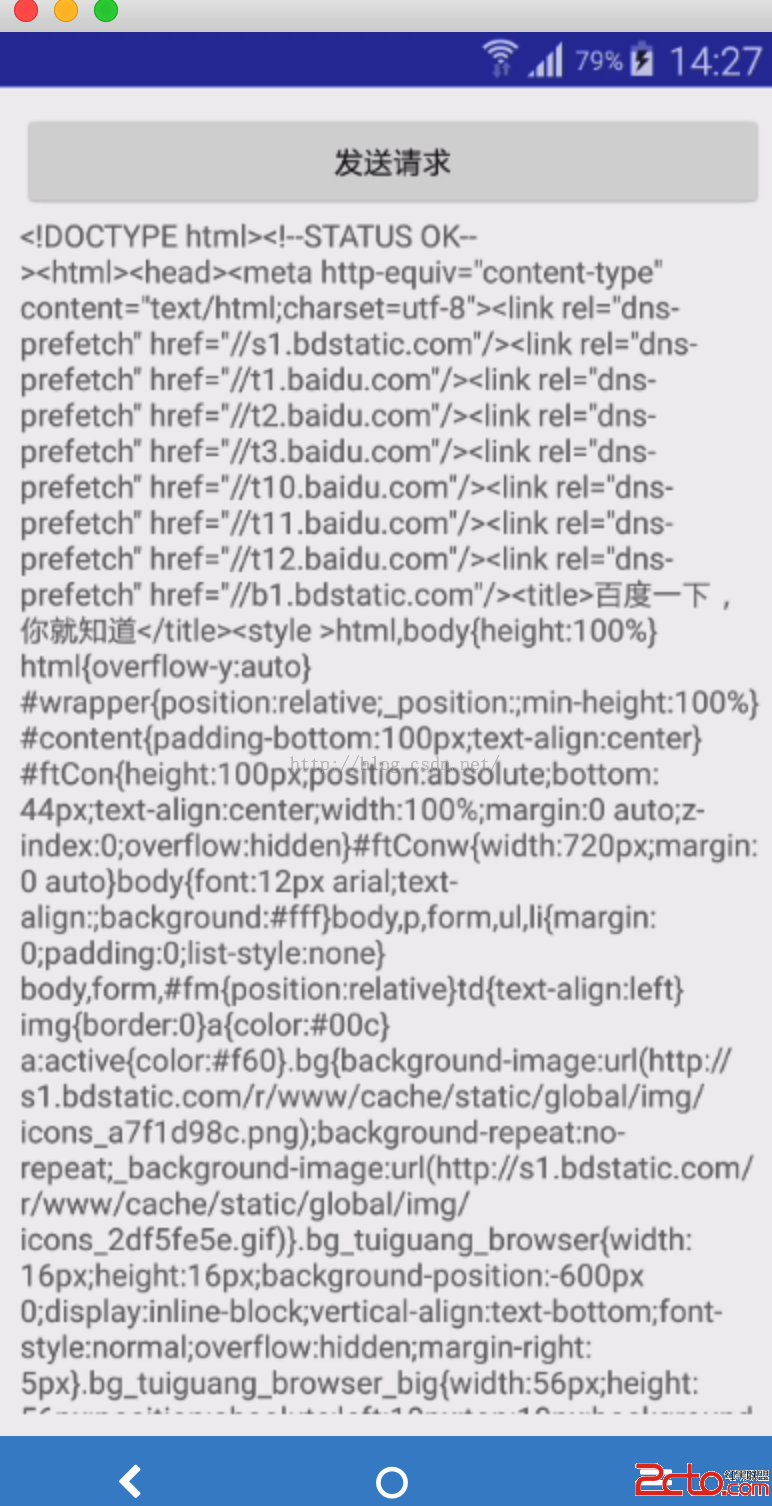
關於Http常用的框架有android-async-http,下面就使用下。jar包可以從官網下載:http://loopj.com/android-async-http/。此外還得下載一個httpclient的jar包:http://mvnrepository.com/artifact/cz.msebera.android/httpclient/4.4.1.1。
修改build.gradle如下:
dependencies {
compile fileTree(dir: 'libs', include: ['*.jar'])
testCompile 'junit:junit:4.12'
compile 'com.android.support:appcompat-v7:23.1.1'
compile files('libs/android-async-http-1.4.9.jar')
compile files('libs/httpclient-4.4.1.1.jar')
}
這裡把兩個包都放在了libs的目錄下。切換到project目錄,如下圖:
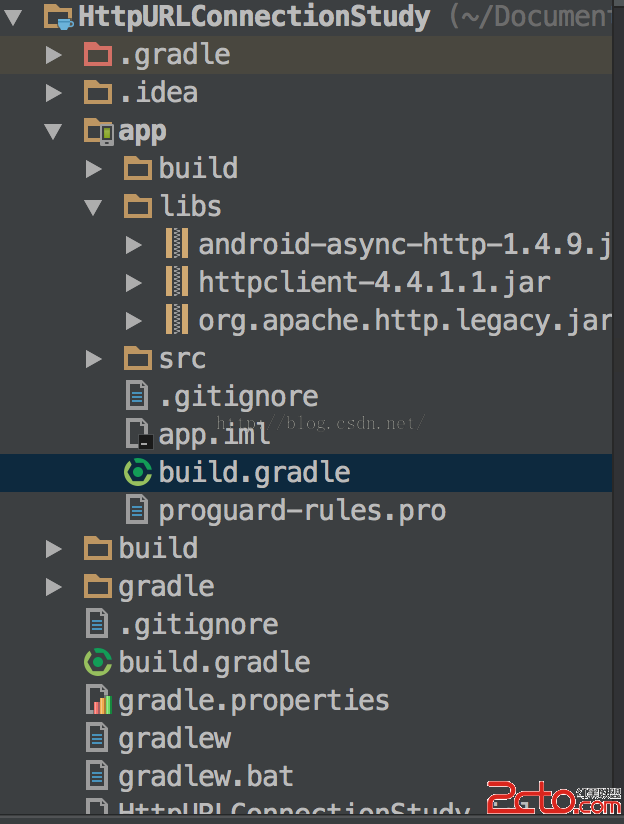
修改MainActivity代碼,添加sendRequestWithAsyncHttpClinet方法如下:
private void sendRequestWithAsyncHttpClient(String url) {
AsyncHttpClient client = new AsyncHttpClient();
client.get(url, new AsyncHttpResponseHandler() {
@Override
public void onSuccess(int i, Header[] headers, byte[] bytes) {
try {
String response = new String(bytes, 0, bytes.length, "UTF-8");
responseView.setText(response);
}catch (Exception e) {
e.printStackTrace();
}
}
@Override
public void onFailure(int i, Header[] headers, byte[] bytes, Throwable throwable) {
}
});
}
運行可以得到我們一樣的效果。AsyncHttpClient很方便地可以使用起來了,比起上面一大堆代碼簡單了不少。這裡通過一個get方法,然後再onSuccess方法中把獲取到的數據轉為String顯示在text就ok了。
關於網絡編程的webview和http就基本學到這裡了。在此還要謝謝朋友的提醒,光學基礎,實際項目會用到很多框架的,需要去熟悉,這裡繼續慢慢學。
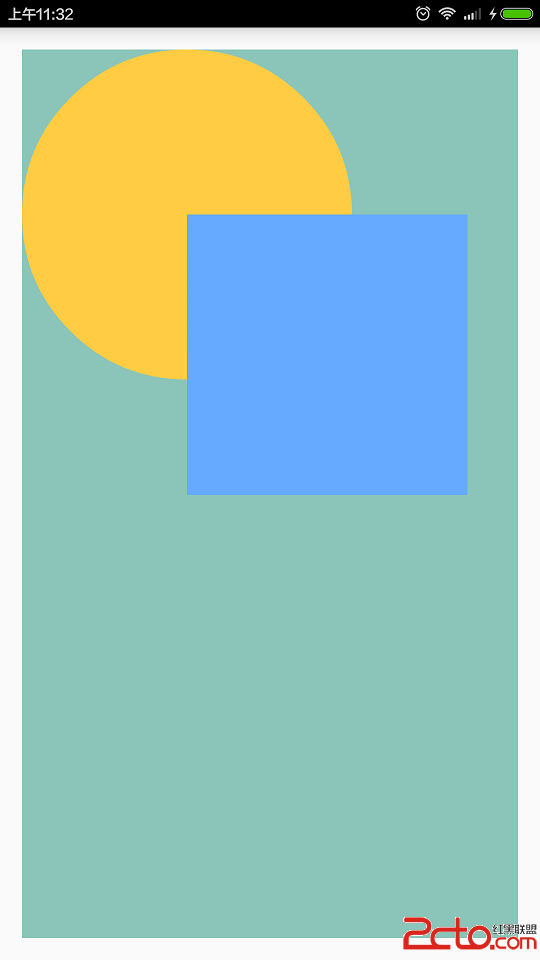 Android中Canvas繪圖之PorterDuffXfermode使用及工作原理詳解
Android中Canvas繪圖之PorterDuffXfermode使用及工作原理詳解
Android中Canvas繪圖之PorterDuffXfermode使用及工作原理詳解 概述 類android.graphics.PorterDuffXfermode
 Android MediaPlayer的生命周期,androidmediaplayer
Android MediaPlayer的生命周期,androidmediaplayer
Android MediaPlayer的生命周期,androidmediaplayerMediaPlayer的狀態轉換圖也表征了它的生命周期,如下: 這張
 Android 5.0 Settings源碼簡要分析
Android 5.0 Settings源碼簡要分析
Android 5.0 Settings源碼簡要分析 概述: 先聲明:本人工作快兩年了,仍是菜鳥級別的,慚愧啊!以前遇到好多知識點都沒有記錄下來,感覺挺可惜的,現在有機會
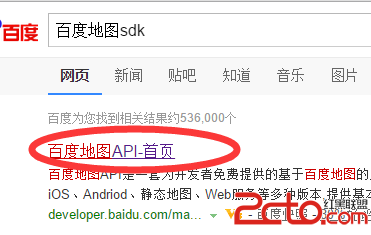 android studio下百度地圖sdk的初體驗
android studio下百度地圖sdk的初體驗
android studio下百度地圖sdk的初體驗 獲取到sha1後,下面開始進入百度地圖sdk的資源獲取; 一、獲取密鑰和SDK; 1、搜索百度地圖sdk; 2、點